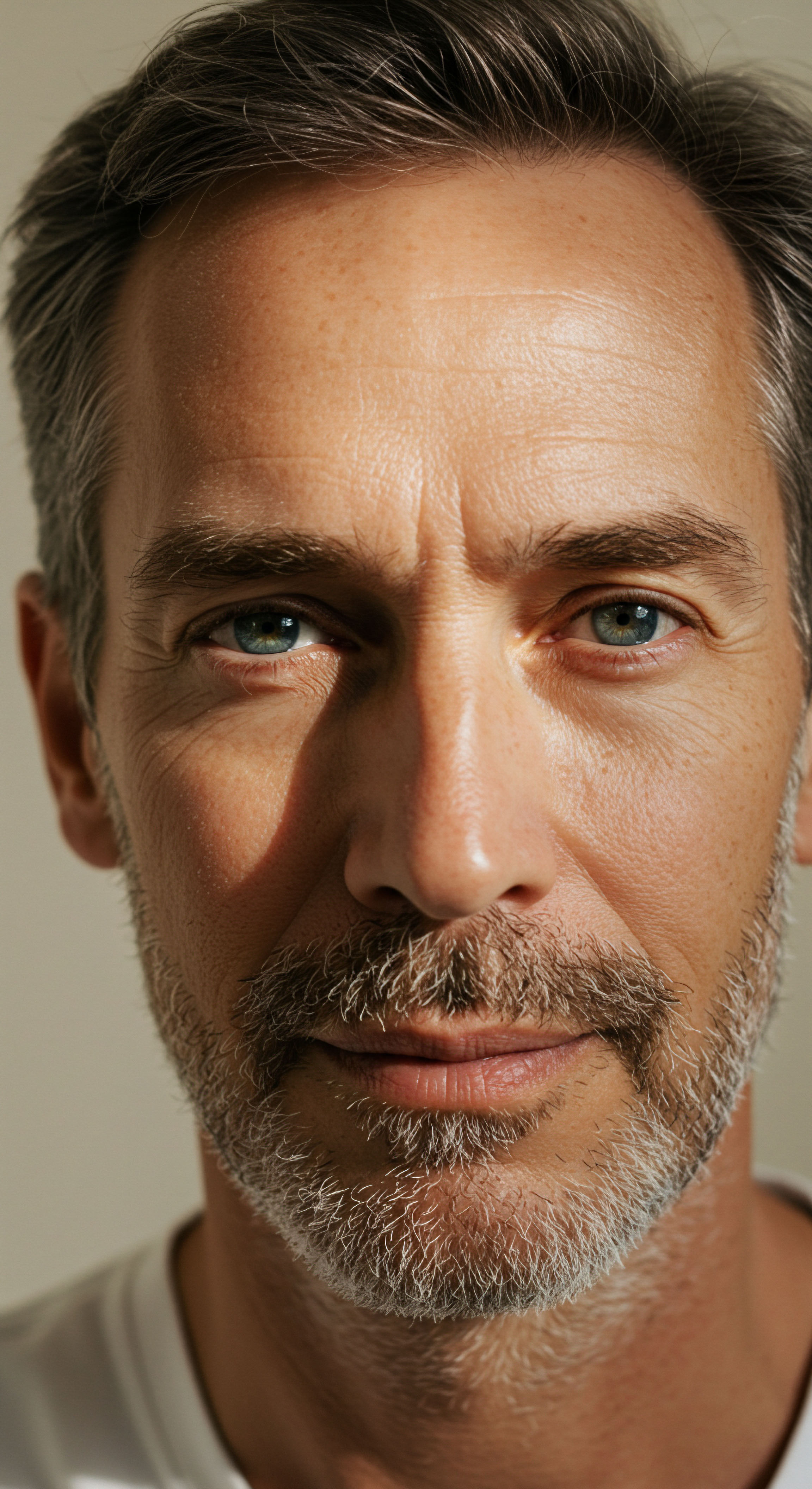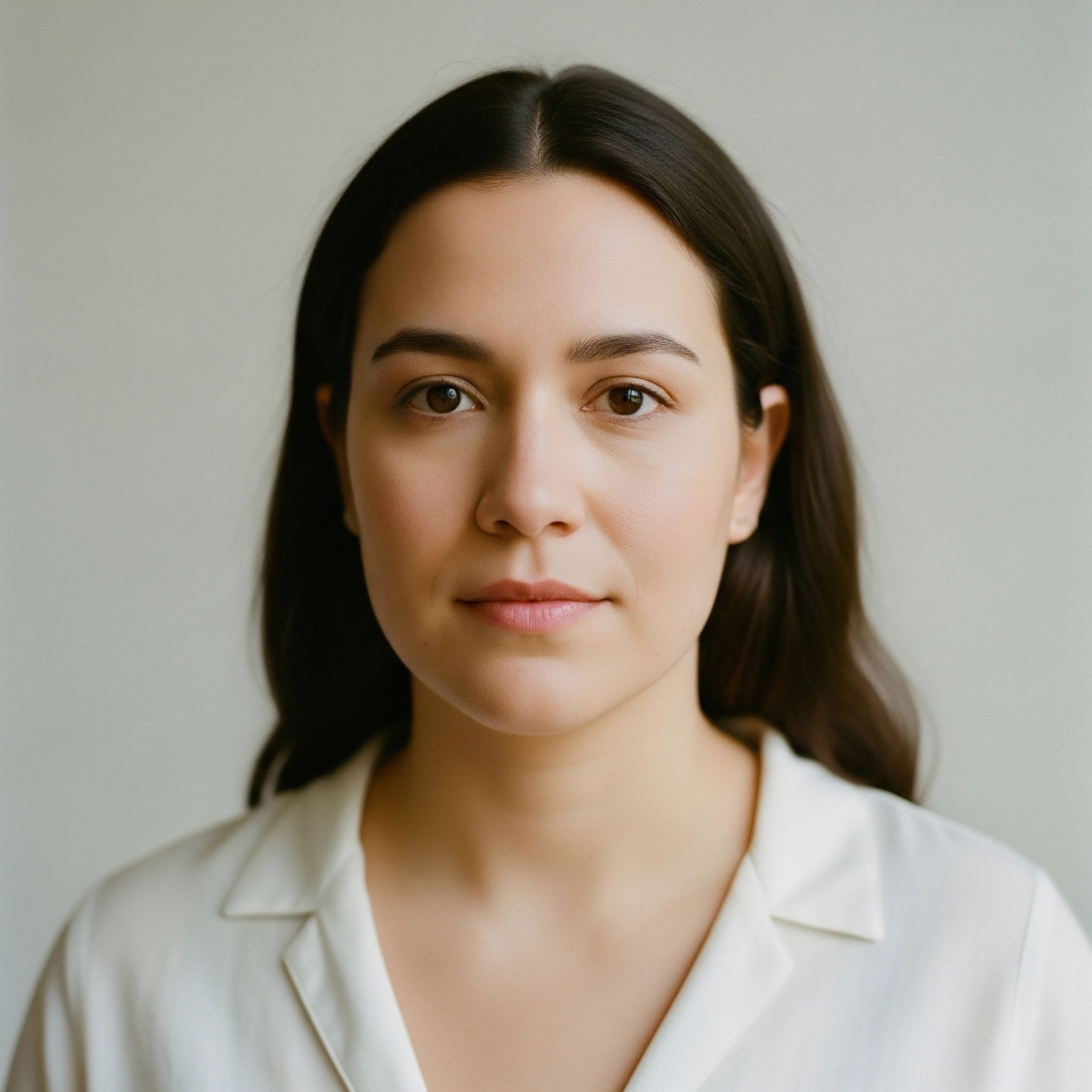

Fundamentals
The reflection in the mirror can feel like a stranger when persistent fatigue settles into your features. You may notice subtle shifts, a certain dullness to your skin, or eyes that seem to carry the weight of sleepless nights even after a full eight hours.
This experience, this visible manifestation of exhaustion, is a deeply personal and often frustrating reality. It’s a signal from your body that its internal communication systems may be faltering. The answer to how hormonal optimization protocols help you look less tired is rooted in understanding that your appearance is a direct expression of your internal cellular health.
Hormones are the body’s chemical messengers, and when they are balanced, they orchestrate a symphony of renewal that reflects outwardly as vitality.
Hormonal fluctuations, particularly the decline of estrogen, progesterone, and testosterone, are a primary driver of the visible signs of aging and fatigue. Estrogen, for instance, is fundamental to skin health. It promotes the production of collagen and hyaluronic acid, two substances that are essential for maintaining skin thickness, hydration, and elasticity.
When estrogen levels decline, the skin’s structural integrity weakens, leading to dryness, fine lines, and a loss of radiance. This process is accelerated during perimenopause and menopause, when the ovaries produce less estrogen. The result is skin that not only looks tired but is also less resilient to environmental stressors.
A balanced hormonal environment is the foundation of cellular repair and renewal, which translates to a more rested and vibrant appearance.
Testosterone, often associated with men, is also a vital hormone for women. It contributes to muscle tone, bone density, and overall energy levels. When testosterone levels are low, it can lead to a loss of facial muscle tone, contributing to a tired or sagging appearance.
Progesterone, another key hormone, has a calming effect on the nervous system and promotes restful sleep. When progesterone levels are imbalanced, sleep can become fragmented and unrefreshing, leading to the telltale signs of fatigue around the eyes. Hormonal optimization protocols are designed to address these deficiencies, restoring the body’s natural ability to repair and rejuvenate itself. By replenishing these vital hormones, we can support the very processes that contribute to a rested and youthful appearance.
The connection between hormonal balance and looking less tired extends beyond the skin. Hormones regulate our sleep-wake cycles, metabolism, and even our mood. When these systems are functioning optimally, we not only feel more energetic but also look more refreshed.
The goal of hormonal optimization is to restore this internal harmony, allowing the body to function as it was designed to. This process is a journey of understanding your own unique biology and working with a clinical professional to create a personalized plan that addresses your specific needs. It is a proactive approach to wellness that empowers you to reclaim your vitality from the inside out.


Intermediate
To appreciate how hormonal recalibration helps you appear less fatigued, it is essential to understand the specific clinical protocols and the mechanisms through which they work. These are not one-size-fits-all solutions but are tailored to an individual’s unique biochemistry, as revealed through comprehensive lab testing.
The primary goal is to restore optimal physiological function by addressing the root causes of hormonal imbalances. For women, this often involves a combination of estrogen, progesterone, and, in many cases, a low dose of testosterone. For men, testosterone replacement therapy (TRT) is the cornerstone of treatment.

Protocols for Female Hormonal Balance
For women experiencing the symptoms of perimenopause and menopause, such as fatigue, sleep disturbances, and changes in skin texture, a carefully calibrated hormonal optimization protocol can be transformative. The specific hormones and dosages are determined by a woman’s symptoms, lab results, and overall health profile. A common approach involves the use of bioidentical hormones, which are molecularly identical to the hormones produced by the human body.
- Estrogen ∞ Typically administered as a transdermal cream or patch, estrogen replacement helps to restore skin elasticity and hydration by stimulating collagen and hyaluronic acid production. It also plays a role in regulating body temperature, which can alleviate night sweats and improve sleep quality.
- Progesterone ∞ Often prescribed as an oral capsule taken at bedtime, progesterone has a natural calming effect that promotes deeper, more restorative sleep. It also balances the effects of estrogen, protecting the uterine lining.
- Testosterone ∞ A low dose of testosterone, usually administered as a subcutaneous injection or a topical cream, can significantly improve energy levels, mental clarity, and muscle tone. For women, even a small amount of testosterone can make a profound difference in their overall sense of well-being.

Protocols for Male Hormonal Balance
For men, the age-related decline in testosterone, often referred to as andropause, can lead to a host of symptoms, including fatigue, decreased muscle mass, and a diminished sense of vitality. Testosterone replacement therapy (TRT) is designed to counteract these effects by restoring testosterone levels to a healthy, youthful range.
| Medication | Purpose | Typical Administration |
|---|---|---|
| Testosterone Cypionate | Primary androgen replacement | Weekly intramuscular or subcutaneous injections |
| Gonadorelin | Maintains natural testosterone production | Subcutaneous injections twice a week |
| Anastrozole | Blocks the conversion of testosterone to estrogen | Oral tablet twice a week |
This multi-faceted approach to TRT ensures that testosterone levels are optimized while minimizing potential side effects. Gonadorelin, for example, helps to preserve testicular function and fertility, while anastrozole prevents the excess estrogen that can sometimes result from testosterone therapy. The result is a comprehensive protocol that supports not only a man’s energy levels and physical appearance but also his overall health and well-being.
By precisely targeting hormonal deficiencies, we can re-establish the body’s natural rhythms of repair and rejuvenation.

The Role of Peptide Therapy
In addition to traditional hormone replacement, peptide therapies can be used to further enhance the body’s regenerative processes. Peptides are short chains of amino acids that act as signaling molecules in the body, instructing cells to perform specific functions.
For example, growth hormone-releasing peptides like Sermorelin and Ipamorelin can stimulate the pituitary gland to produce more of its own growth hormone, which plays a vital role in tissue repair and cell regeneration. This can lead to improved skin quality, increased muscle mass, and a more youthful appearance. These therapies are often used in conjunction with hormonal optimization protocols to achieve a synergistic effect, addressing the signs of aging and fatigue from multiple angles.


Academic
A sophisticated understanding of how hormonal optimization mitigates the appearance of fatigue requires a deep exploration of the interconnectedness of the endocrine, nervous, and integumentary systems. The visible signs of tiredness are the macroscopic expression of microscopic cellular dysregulation. Hormonal therapies, when applied with clinical precision, are a form of biochemical recalibration, targeting the fundamental processes that govern cellular health, energy metabolism, and tissue regeneration.

The Hypothalamic-Pituitary-Gonadal Axis and Its Influence on Appearance
The Hypothalamic-Pituitary-Gonadal (HPG) axis is the master regulator of sex hormone production. In both men and women, the hypothalamus releases Gonadotropin-Releasing Hormone (GnRH), which signals the pituitary gland to release Luteinizing Hormone (LH) and Follicle-Stimulating Hormone (FSH).
These hormones, in turn, stimulate the gonads (testes in men, ovaries in women) to produce testosterone and estrogen, respectively. Age-related decline in the function of the HPG axis leads to a cascade of effects that manifest as the signs of aging and fatigue.
In women, the decline in ovarian estrogen production during menopause has profound effects on the skin. Estrogen receptors are present in keratinocytes, fibroblasts, and melanocytes, and the loss of estrogen signaling leads to a decrease in collagen synthesis, a reduction in dermal thickness, and impaired wound healing.
This results in the characteristic signs of skin aging ∞ thinning, wrinkling, and a loss of elasticity. By restoring estrogen levels through hormone replacement therapy, we can directly counteract these degenerative changes, promoting a more youthful and rested appearance.
| Hormone | Primary Effects on Skin | Visible Outcome of Optimization |
|---|---|---|
| Estrogen | Increases collagen and hyaluronic acid production, maintains dermal thickness | Improved skin hydration, elasticity, and reduced wrinkling |
| Testosterone | Contributes to sebaceous gland function and skin strength | Enhanced skin tone and texture |
| Growth Hormone | Stimulates cell regeneration and tissue repair | Increased skin thickness and improved wound healing |

How Does Testosterone Affect Sleep Architecture?
The relationship between testosterone and sleep is bidirectional. Low testosterone levels are associated with poor sleep quality, and insufficient sleep can, in turn, lower testosterone levels. Testosterone plays a crucial role in regulating sleep architecture, the cyclical pattern of sleep stages that the brain progresses through during the night.
Specifically, testosterone appears to influence the amount of time spent in deep, restorative slow-wave sleep (SWS) and rapid eye movement (REM) sleep. Men with low testosterone often experience fragmented sleep, with more frequent awakenings and less time in SWS. This leads to the subjective experience of non-restorative sleep and the objective signs of fatigue.
Testosterone replacement therapy can help to normalize sleep architecture, leading to more consolidated and restful sleep. This improvement in sleep quality has a direct impact on appearance, as the body’s regenerative processes are most active during sleep. Cellular repair, collagen synthesis, and the clearance of metabolic waste products are all enhanced by a healthy sleep cycle. By optimizing testosterone levels, we can support the very foundation of a rested and revitalized appearance.
The visible signs of fatigue are a direct reflection of the body’s internal hormonal and metabolic state.

The Role of Growth Hormone in Tissue Regeneration
Growth hormone (GH) is a key player in the body’s ability to repair and regenerate its tissues. Produced by the pituitary gland, GH stimulates the production of Insulin-like Growth Factor 1 (IGF-1), which in turn promotes cell growth and proliferation throughout the body.
GH and IGF-1 have a profound effect on the skin, stimulating the production of collagen and elastin, the two proteins that give the skin its strength and elasticity. As we age, GH production naturally declines, contributing to the thinning and sagging of the skin that is characteristic of aging.
Peptide therapies that stimulate the body’s own production of GH, such as Sermorelin and Ipamorelin, can help to reverse these age-related changes. By increasing GH and IGF-1 levels, these therapies can enhance the skin’s regenerative capacity, leading to a thicker, more resilient, and more youthful-looking complexion. This approach to rejuvenation is not merely cosmetic; it is a fundamental restoration of the body’s innate ability to heal and renew itself.

References
- Stanczyk, F. Z. (2020). Treatment of Symptoms of the Menopause ∞ An Endocrine Society Clinical Practice Guideline. The Journal of Clinical Endocrinology & Metabolism, 105(3), 549-565.
- Thornton, M. J. (2013). Estrogens and aging skin. Dermato-endocrinology, 5(2), 264 ∞ 270.
- Wittert, G. (2014). The relationship between sleep disorders and testosterone in men. Asian journal of andrology, 16(2), 262 ∞ 265.
- Kahn, S. A. & Vigen, R. (2010). Growth hormone therapy in adults with growth hormone deficiency ∞ a review of the literature. Endocrine, 38(2), 137-149.
- Schüssler, P. Kluge, M. Yassouridis, A. Dresler, M. Held, K. Zihl, J. & Steiger, A. (2008). Progesterone reduces wakefulness in sleep EEG and has no effect on cognition in healthy postmenopausal women. Psychoneuroendocrinology, 33(8), 1124-1131.

Reflection
Understanding the intricate dance of hormones within your body is the first step on a path toward reclaiming your vitality. The information presented here is a map, but you are the explorer of your own unique terrain.
The journey to looking and feeling less tired is a personal one, a process of aligning your internal biology with your desired state of well-being. This knowledge is a tool, empowering you to ask informed questions and seek personalized solutions. The reflection you see in the mirror is not a final destination but a dynamic expression of your inner health. What you do with this understanding is the next chapter in your personal health story.

Glossary

hormonal optimization protocols

perimenopause

testosterone levels

hormonal optimization

testosterone replacement therapy

bioidentical hormones

skin elasticity

andropause

hormone replacement

growth hormone

ipamorelin

collagen synthesis

hormone replacement therapy

sleep architecture




